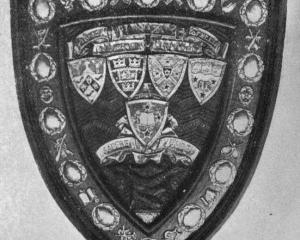
The British Museum has a very representative collection of New Zealand curios. It is fit and proper that, it should have. The collection is for the benefit of the nation. But outside public institutions there are valuable specimens which come in to public auction from time to time.
Yet this week I have met an enthusiast whose love of New Zealand ethnographical specimens is as great as that of any local collector. For nearly four hours I examined and handled his Maori specimens, and listened to such stories as he had to tell of them. In the case of most of them their history has been lost in passing from hand to hand.

Among the preserved heads none is more interesting than that brought away by Henry Wilson, a commander of a ship out there in 1780. The original tattooing is perfect, but for some unknown reason there are post-mortem cuts on the face over the top of the pattern. As there was at that time no trade in heads it is difficult to understand why the face should thus be marked. One other perfect in preservation but its origin unknown is fully tattooed except for the upper part of the forehead, and here half of a chief’s distinguishing mark has been cut after death. One side of the forehead has been left as though the purchaser had been in a hurry to get away with his trophy.
A curious fishhook attracts the attention. It is made from a human jawbone. Probably the owner thereof was a skilled fisherman, and his friends wished to perpetuate his luck in catching sharks.
And here is an overdoor piece. "That is the finest specimen of its kind I have ever seen," said my host. It was very beautiful. The figure was wonderfully wrought, the arms turning into the parrot formation.
As for feather boxes, they were numerous, costly and beautiful, some made with with the old obsidian tools, others in later times with steel implements.
Incidentally it may be mentioned that the finest tiki in England is to be found in the Geological Museum, in Jermyn Street. There was a suggestion to sell it some time ago and my host offered £120 for it, but the British Museum authorities placed an embargo on it, and so it remains where it was. It is eight inches long. Four or five perfect specimens of greenstone meres are also to be seen. Each one of those today would cost £100. Their origin, however, is unknown, though one bears the inscription "Given by Hone Heke." A whalebone axe or wahika has a history. The faded inscription reads "Brought from New Zealand in 1777 by Midshipman Burr, in the Discovery."
One other article seems to have a touch of romance about it, and possibly those who know Maori history may be able to throw more light on it — a toki or greenstone hatchet with short handle attached . It is a perfect niece of "whitebait" greenstone, and the small wooden handle has suffered from dry rot. "Maori axe called Tutaura, belonged to Purahokura, given to Miss Jam (the rest of the word is indecipherable) by her great uncle, 1791." Perhaps others can fill in the gaps of this interesting fragment of history. — Specially written for the Otago Daily Times by T.J. Pemberton
— ODT, 11.11.1922 (Compiled by Peter Dowden)












